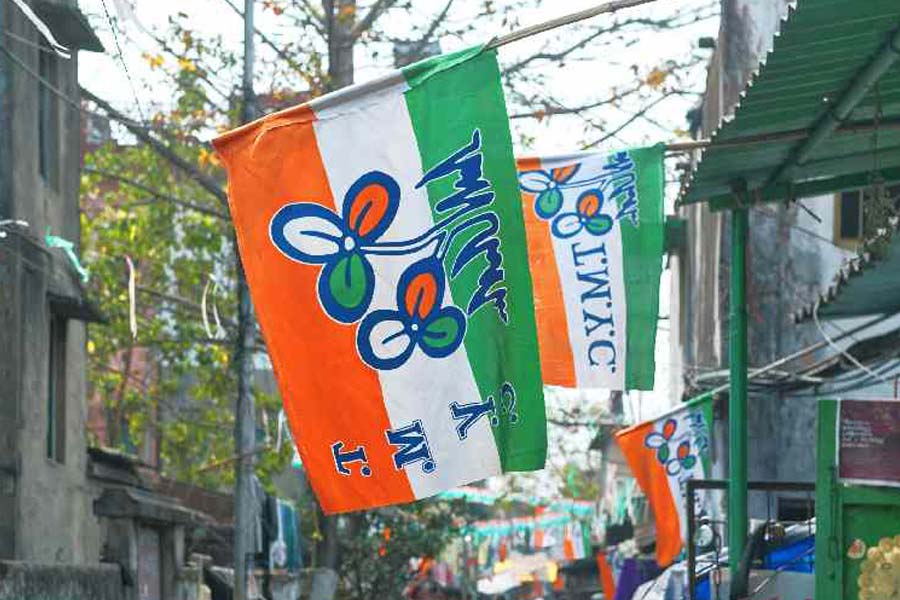 |
 |
 |
 |
 |
| (From top to bottom): Students at The Heritage School’s computer lab; a boy practises his strokes at the DPS Megacity tennis court; principal Manju Ahluwalia with students at Adamus International; a dance class in progress at The Heritage School; students work out in the Cambridge School’s gym |
| Schooled for success |
| Facilities offered by most of the new-age schools: • Sophisticated sporting • Hi-tech facilities • Day boarding • Regular health checks • Emphasis on extra-curricular activities |
Is this the wave of the future for Calcutta schools? PCs for all students and close-circuit television in classrooms, state-of-the-art athletic facilities and air-conditioned coaches for the pupils? DPS Megacity certainly thinks so.
And DPS isn?t the only one hoping to give Calcutta?s younger generation a new style of education. Peep into the classrooms at Adamus International built on nine acres on the city?s outskirts. Or look at the three-year-old Heritage School that has embarked on a project to transform itself into a paper-free campus. And in the comfort realm, pupils at Cambridge School have air-conditioned classrooms.
Calcutta schools were never slowcoaches in the education game. But the new breed of schools coming up in places like Rajarhat, Belgharia and Anandapur are playing by a new set of rules. They are reaching out for the best technology and throwing in the best out-of-classroom facilities on offer for their students.
?It?s high time parents were given more options in terms of the upbringing that they want for their children,? says Melville Samuel, principal, DPS Megacity.
Certainly, DPS Megacity, which opened its classrooms earlier this year, is thinking on a mega-scale. Construction will soon start on a 1,100-seater amphitheatre and if that isn?t enough there will also be a 1,050-seater air-conditioned auditorium. In addition, the school?s also building a residential complex for 400 boarders. The DPS Megacity campus is spread over a sprawling 14 acres.
And it?s backing that with technology. Starting from the 2005-2006 academic session, all student records will go onto smart cards. So parents will be able to log onto the school website, tap in a password and learn all about their child?s progress in school. The smart card will have information on everything from daily attendance records and canteen expenses to teachers? comments and records of reports and grades.
The Heritage School isn?t about to be left behind either in the technology race. It has 24-hour Internet connectivity and classrooms and labs are linked by local area networks. In addition, the school has cable television and its buildings are linked by the best quality Avaya fibre optic equipment.
?By being networked through a system of optical fibres, our classrooms serve as a comprehensive medium for disseminating information,? says Neelkanth Gupta, principal, The Heritage School. For those of you who are saying ?wazzat mean??, he says, ?It?s an undisputed fact that visual motifs have become more powerful in the current day and age.? Therefore, when a class is introduced to the human circulatory system for the first time, it helps if students look at a CD ROM about the subject and comprehend the intricacies through virtual reality.? The whole aim of having multimedia facilities in each classroom is to ?ensure that the learning experience is enjoyable as well as simpler,? says Gupta.
Gupta?s views about technology in the classroom are backed by other principals. ?Present-day education draws its sustenance from communication. Through the profusion of sophisticated facilities, we are empowering students with discerning abilities,? says Meenakshi Atal, headmistress, The Heritage School,?
The new approach to education begins from the moment the children leave home. The Heritage School insists that all its students travel by school bus. But the school buses at Heritage School aren?t like the vehicles that most parents probably remember from their youth. These are smart, air-conditioned coaches equipped with wireless connections so the school can keep track of them.
Some parents may think this a gimmick to make the school more pricey. But the school says it builds friendships. Says Gupta: ?Travelling in the same transport fosters camaraderie among the students. It also ensures that the sense of disparity is minimised.?
It?s a similar story at Adamus International which has smart air-conditioned coaches and lady attendants for toddlers. All the school buses are fitted with safety belts for the youthful passengers.
Most importantly, the ?new age? schools firmly believe there?s life beyond the classrooms. That?s why they promise sophisticated facilities for all students. The Heritage School sprawls over 10 acres and has everything from an athletic track to cricket and football grounds. There are also volleyball and basketball courts plus a swimming pool and gymnasium inside the complex. Says Gupta: ?We?re here to make schooling a happy experience and show children that there?s a life beyond grades.?
It goes without saying that these facilities cost money ? lots of it. The initial construction cost of both The Heritage School and Adamus International is around Rs 12 crore. And the Maa Saraswati Gyan Mandir Education Society, which manages DPS Megacity will be spending a whopping Rs 33 crore.
And obviously, these schools aren?t banking solely on technology and fancy infrastructure to ensure good teaching. They are all keeping a careful eye on the important teacher-student ratio. Currently DPS Megacity has a teacher-student ratio of 1:30 and at Cambridge School, it?s 1:20. The topper in this category is, however, The Heritage School, boasting an incredible 1:13 ratio.
Adamus, currently, has 40 teachers for an enrolment of 550 students. Says principal Manju Ahluwalia, ?Close interaction between the teacher and the students inspires them to improve their performance at every level.?
So what is the bottom line? How much are the fees for this five-star educational package? The annual fees at both DPS Megacity and The Heritage School add up to around Rs 80,000. Adamus is slightly cheaper, at around Rs 60,000 per annum for an eighth standard student.
That may seem expensive but the schools insist that it?s not as steep as it seems. For a start, most of these schools offer ?day-boarding?, which means that the children leave in the morning, eat lunch in school and only return in the evening ? that?s a schedule that suits the hectic timetables of many working parents.
To feed its students, The Heritage School has an air-conditioned dining hall where nutritious vegetarian meals are dished up under the supervision of a trained dietician three times a day. Says Atal, ?Meal times are occasions for bonding between the student and the teacher.? At the same time, a child also learns how to behave at the table or, as Atal says, is ?introduced to the nuances of table manners, etiquette and poise?. Adds Gupta, ?When the student and the teacher share a meal, the distance between them gradually melts away.?
Adamus says its menu is chosen with great care. ?We ensure that the diet is the right mix of carbohydrates, proteins and minerals and is therefore adequate for proper growth of the body,? says Indrani Moitra, nutrionist at Adamus.
Staying on in school also solves the perennial problem of homework ? that?s done during the prep hour in school. During the prep hour, students sit with their teachers and solve problems that have already been done in class. This is a two-pronged strategy to promote analytical skills among students. Along the way, the teachers get to spend quality time with students and hence, acquire a firsthand knowledge of their frailties,? says Ahluwalia.
This system also has other obvious advantages. This way, students aren?t burdened by too much prep when they go home and their harried parents don?t have the additional difficulty of wracking their brains over geometry and chemistry. ?Although it?s difficult to eliminate homework in its entirety in higher classes, we ensure that it?s kept out of reach of toddlers, says Ahluwalia,?
Each of these schools has giant plans for the future. In fact, some educationalists might think the plans are too big. The Heritage School has a total strength of 1,500 students and says it won?t be expanding further. But DPS Megacity which currently has about 1,200 students plans to have about 5,000 in a few year?s time. Similarly, Adamus, which now has 550 students, also hopes to have about 5,000 students once its infrastructure is complete.
Anyone who thinks these schools are expensive should check out ?new age? educational facilities in other parts of the country. In Delhi, schools like Pathways charge about Rs 3 lakh a year. A couple of other schools in Mumbai and Hyderabad are also asking parents to fork out similar sums for their children?s education.
What backgrounds do the children at these schools come from? Are they mostly the children of working parents? Samuel says that?s not the case. In fact, he says that students come from a large cross-section of society and, thus, defy being pigeon-holed. And the schools say they have tried to encourage children from different backgrounds. Even if, for instance, their English is not that good, Samuel says their language skills will improve by the time they reach the higher classes.
Ahluwalia says that Adamus has also taken children from all types of backgrounds. ?Pupils who?ve studied in schools where the medium of instruction was vernacular, have enrolled for our current academic session. We do not want to discourage them as we are entrusted with the responsibility of honing their skills.?
Inevitably, all these schools have plans to offer international degrees ? that?s essential these days with so many students planning to study abroad. Students at Adamus will soon be able to study for the international Baccalaureate degree, says Ahluwalia.
Similarly, the one-and-a-half-year-old Cambridge School prepares students for the ?? and ?A? level degrees offered by the University of Cambridge. The school has several teachers with international degrees who are familiar with these teaching methods. In other ways too, Cambridge School ? which unlike the other new schools has quite a small campus ? aims to prepare students for a life outside India. It offers foreign languages and puts a strong emphasis on co-curricular activities.
What do the students think about these facilities? Take a look at Jivraj Singh who is currently studying for his ?A? level degree at Cambridge School, ?I left a good Calcutta school that offered a conventional degree to study at Cambridge because of the flexibility of its curriculum. I can study science and humanities together and this will help me in the future.?
That probably sums up the attitude of a new generation of students and parents who want more for their children. The new schools are out to get results. But they also believe that all work and no play will make Jack a dull boy. And they believe today?s parents want to avoid that ? even if they have to fork out a hefty fee for it.











